#I like when things come in numbered lists such as Durin I to Durin VI matching to the first 6 eras in my ER astrology timeline
Text
Elden Ring and Tolkein's Legendarium
In a way, Elden Ring as a game can be viewed a deconstruction of all things common in "fantasy".
It has been said that the Lord of the Rings is the origin of the high fantasy genre. The first step of a deconstruction (or of duplicating results) is to look at a thing and examine the elements it is made of. The more general the better - the goal is to find the things that inspired the thing:
The setting is inspired by research into many real world mythologies and folk tales. And Tolkein's religious beliefs as a Catholic.
Tolkein invented full language systems that were used to add extra significance to the names of people and places
The personal history and psychology of the author had an undeniable influence on the themes of the story (when Tolkein writes about the devastation of war it is from a place of sincerity - because he lived it)
So, these are the ingredients of a successful fantasy story that also apply to Elden Ring - draws parallels to previous fantasy stories, use of exotic words and naming schemes that are internally consistent as parallel to the real world, and incorporates psychologically-driven themes (in the case of Elden Ring I believe that it is less of the psychology of a person and more about drawing on the psychology of the gaming company FromSoftware...but that is a topic covered in other posts).
But regarding the works of Tolkein there are a few more...explicit parallels to be drawn. Which for legal reasons regarding the rights to adapt Tolkein's Legendarium will likely never ever be confirmed by FromSoft. But as I see it getting references under the radar of the copyright lawyers is a time honoured tradition of fantasy stories so I will attempt to explain these connections as I see them, regardless.
A linguistic connection is formed in the space between two main points that I am aware of: Gelmir of Nargothrond as the possible naming inspiration for Mt. Gelmir, and geographical region "Taur-en-faroth" containing part of the name used for Fort Faroth.
Gelmir
"J.R.R. Tolkien has become a sort of mountain, appearing in all subsequent fantasy in the way that Mt. Fuji appears so often in Japanese prints. Sometimes it’s big and up close. Sometimes it’s a shape on the horizon. Sometimes it’s not there at all, which means that the artist either has made a deliberate decision against the mountain, which is interesting in itself, or is in fact standing on Mt. Fuji." - Terry Pratchett
First addressing Gelmir - literally the volcanic mountain is a reference to Tolkein. As clear of a declaration as possible that Elden Ring intends to stand on Mt. Fiji.
Gelmir in the "canon" version of the Legendarium was an elf of Nargothrond who was captured by the forces of Morgoth at the "Battle of Sudden Flame" which was the fourth great conflict in the War of the Jewels (the war over the 3 silmarils for which "the Silmarillion" is named). He was subsequently blinded and tortured for 17 years until his death - after having his limbs cut off to taunt his brother Gwindor into attacking recklessly - at the start of the fifth great conflict known as "The Battle of Unnumbered Tears". Gwindor himself was captured and held prisoner for an additional 17 years after this battle, before escaping at the expense of having a hand cut off and eventually dying in another battle of the war. He was in love with a golden-haired elf maiden named Finduilas (name meaning "hair of spring leaf") who he also called "Faelivrin" meaning "Gleam of the Sun on the Pools of Ivrin" ("Pools of Ivrin" being a location in the land called Beleriand). She was killed before the end of the war by being nailed to a tree with a spear.
For context, the sixth great conflict was called "The War of Wrath" and was the final one. Morgoth brought dragons to the battle to blast the battlefield with fire and lightning - which had never been done in any previous battle - and the outcomes were that Morgoth was beheaded and kicked through a portal into the void and the northwest corner of the map including almost all of Beleriand (an area equal to the size of the entire Middle Earth map at the time of the Lord of the Rings story!) sunk into the ocean.
There is a lot to work with here already - first being Gelmir's associations with flame and imprisonment and torture that are shared by both Tolkein's and Elden Ring's purposes. Blindness is noteworthy, considering how often this is a theme with Elden Ring characters and even partial blindness is enough to cause madness as indicated by the Prisoner Helmet. Taking a few lateral steps arrives at a golden haired maiden who shares the method of execution used for Marika. And her name meaning "gleam of the sun on the surface of the water" exactly describes the imagery seen in the Elden Ring item "Memory of Grace".
But there's still more to spin from this line! Because Finduilas had another lover named "Túrin Turambar" who was a friend of Gwindor and whose family line had been cursed by Morgoth. Túrin owned a magic helm upon which was perched an image of the Golden Dragon Glaurung - similar to the style of helmet worn by Elden Ring's Banished Knights - and which allowed him to survive dragon fire. Túrin found on the grave of Finduilas a naked woman who he called "Níniel" or "Maiden of Tears" - because she had lost her memory and was crying - and wed her with neither knowing that they were estranged brother and sister (this is based on the Finnish story of Kullervo, with which Tolkein was especially fascinated). This was revealed to them later to be a machination of Glaurung when Túrin was in the midst of slaying the dragon, and subsequently both Túrin and Níniel self-destructed. Before meeting his end, Túrin also described himself in (probably) poetic terms as having blindness being the curse placed upon him by Morgoth, which is assumed by readers to be more a matter of tunnel vision or short sightedness rather than literal blinding. He is also apparently prophesied to return to life someday in the supplementary materials.
What this means exactly for Elden Ring is up to interpretation. A story could be spun by combining Gelmir, Gwindor, and maybe even Túrin into a single character who are motivated by unrequited and/or incestuous love - to fill in the empty spaces around the characters of Marika, Radagon, and Godfrey. But there is even more nuance here because there are the alternate Gelmir's to consider.
In one version, Gelmir was king of the gnomes, by which Tolkein was inspired by the Greek "gnōmē" meaning "thought" or "intelligence". But this was dropped due to the cultural confusion with gnomes being wrinkly little creatures.
In another version Gelmir was the same character as Finwë, an elf who was born during the "Years of the Trees" that preceded the era called the "Years of the Sun". At this time, the light of the world was confined to the Lands of the Valinor (a pantheon of Creator types) in the west provided by the female golden tree named Laurelin in the south and the male silver tree Telperion in the north. Finwë's wife was a weaver named Míriel Therindë and his son Fëanor was responsible for forging the Silmarils and jealously guarding them (And also he invented the 7 palantíri scrying stones + 1 master stone, and the Tengwar writing system). The grandson of Fëanor and last of his line was Celebrimbor, meaning "silver fist". Celebrimbor forged the three rings for the elves (named for air, fire, and water) that were subject to the One Ring but never corrupted by it. So, yeah, it's possible that "Gelmir" is selected for being a seemingly niche character who was actually in another lifetime very closely connected to these core events of the history.
The 3 Silmarils contained the remaining light of the two trees that were destroyed and had the sun and moon forged of their fruits by blacksmith Aulë. When the trees were first made they were sung into existence by Yavanna and watered by the tears of Nienna (who was a teacher of the wizard Gandalf and in earlier versions of the Legendarium called "Queen of Shadow"). Nienna again wept healing tears upon the trees to grow the fruits when they were dying. Morgoth stole the Silmarils and set them into his Iron Crown, and upon his defeat the stones were pried out and the crown beaten into a collar for his neck (in the brief period of time before he was kicked into the void anyways). One Silmaril was thrown into the sky where it became the Evening Star. Another was cast into the sea. And the third was cast into a firey pit in the earth along with its possessor.
And as an addition, it is not farfetched that Morgott = Morgoth is an intended spiritual parallel. Considering that Morgoth was indirectly responsible for the blinding and killing of Gelmir (brother of Gwindor) in Tolkein's mythic history. And in Elden Ring this seems expressed in the Shattering War though Morgott pursuing Mt. Gelmir most fiercely. Also, Morgoth was the identity taken by Melkor after he was released from the chains made to bind him by Aulë, which is paralleled by Morgott being the name used by the previously bound Margit (it is called 'Margit's Shackle').
Faroth
"Faroth" is a Sindarin word meaning "hunters". The "Hills of the Hunters" (Taur-en-faroth) was a location in West Beleriand, the aforementioned western part of the continent that sunk into the ocean at the end of the War of the Jewels. In these hills was hidden the secret elven city of Nargothrond. The same from which Gelmir of Nargothrond is associated. The city began as a Dwarven Hall for the petty dwarfs (exiled and unsociable dwarfs smaller than typical dwarfs), was conquered and ruled by the House of Finarfin (a son of Finwë), and was sacked and turned to the lair of the dragon Glaurung some time after The Battle of Unnumbered Tears. And then fell into the ocean.
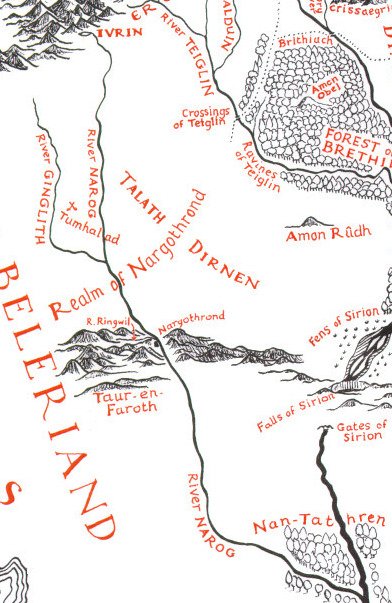
At this point there are too many names, so I sketched a family tree of all of these elves:
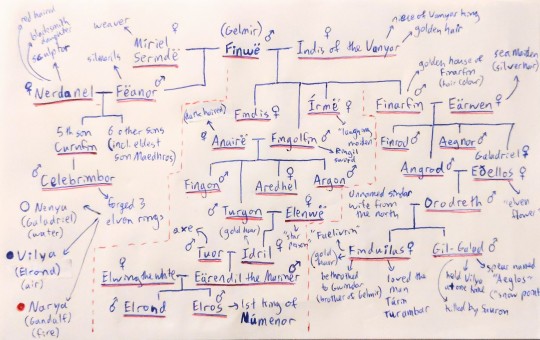
Some general trends:
Of the 3 family lines the middle one has significance for being the one to produce the Númenor Kings of Men
The family lines at the two sides have plot significance as discussed in the Gelmir section, but then just kindof die off.
Typically only the male lines matter for continuity, except for Idril in the 3rd generation removed from Finwë. The origins of the women spouses and daughters mostly are otherwise not mentioned or appear and disappear as needed from the aether (with 3 exceptions: Indis has a famous uncle, Nerdanel has a significant blacksmith father, and Eärwen's extended family has some substance to it)
If a writer wanted to do a legally distinct take on this mythology while borrowing from it for whatever reason, it would be easy to condense the feats and characterization of these 3 lineages into one truncated one. Maybe fuse Finduilas with Idril - two blonde ladies with minimal character - and also fuse together their lovers and you have a Marika + Godfrey. The narratively satisfying thing about Finduilas being associated to Gwindor (who is practically the same character as Gelmir) is that it creates a closed loop for the whole lineage when Gwindor/Gelmir is substituted for Finwë, which is a very attractive proposition for a story where time is a wheel and regression to the origin point is a principle of the Golden Order.
Also this region calls attention to the significance of the river Ringil. That word comes up as: 1) a mountain river through Taur-en-Faroth that is tributary to the Narog river, 2) a sword held by Fingolfin (another son of Finwë), and 3) as the primordial tower - possibly made of ice - upon which sat the south lamp Ormal (an orb containing the gold light of the world in the First Age that would later pass to the gold tree Laurelin in the Second Age). In an earlier version of the writings. The blacksmith Aulë created the lamps at the request of Yavanna, who was herself responsible for the growth of fruits and trees. The end of the "Days before Days" (which preceeded the "Years of the Trees") occurred with the breaking of the lamps by Melkor, after a period of time where he had poisoned the land and caused the things made by Yavanna to rot.
There is a confusing timeline here in the early history with spans of time lit only by the stars between the destructions of these various sun/moon light sources, with Yavanna singing all living life to sleep due to the lack of light except maybe the elves are still awake and doing things? The lamp and tree stuff and a bunch of elf stuff happens before the First Age of history, but the start of the First Age is also called "The Awakening" so again I don't grasp the sleep thing. Aulë was also responsible for creating the "Seven Fathers of the Dwarves", but he made them too early and they had to go to sleep so that the elves of Ilúvatar could pretend to be the first sentient mortal life? I have lost interest in interpreting the mythic timeline, so I'll just end this with more context for the lamps:
"In the middle of Arda, where the light of the lamps mingled, amid the Great Lake lay the Isle of Almaren, where the Valar dwelt." - The One Wiki to Rule them All
"In J.R.R. Tolkien's older writings (not used in the published version of The Silmarillion), the Valar sought peace with Melkor, asking his assistance with fixing the lamps upon Arda. Melkor, still envious and hateful of the rest of the Valar, agreed to give them a strong, sturdy substance. He gave Aulë ice. Melkor permitted the Valar to do as they wished until the fateful day when the Lamps' light and heat finally melted the ice. The pillars crashed upon Arda, flooding it with water and darkness." - The One Wiki to Rule them All
I suppose that if I have a point here it is that Radagon's Sore Seal talisman is found at Fort Faroth, which through the winding etymology of words is tied to Mt. Gelmir. Perhaps the blind Radagon was a hunter on a fruitless quest seeking the lost light of the Golden Sun from the days before days - guided by the distant memory of the reflection of it's light on the water. Perhaps there is other meaning to be found. After a certain point any interpretation found through these linguistics should be cross-referenced with everything that can be learned from all other sources of information in the game.
The Rings of Power
The big brazen choice - in my opinion - was to name the big metaphysical artefact "the Elden Ring"...and then draw direct parallel to the Rings of Power. Not the 3 rings granted to the Elf Kings under the sky - I've yet to identify how or if those are expressed in game. Not the 9 rings granted to Kings of Men either - those are seemingly represented in the 9 Night's Cavalry (and possibly the 9 weapon talismans that each feature a ring at the top of the head) . What is most relevant here are the 7 Great Runes matching "seven for the Dwarf-lords in their halls of stone".
The first critical part of that phrase is the reference to "stone", as I have brought up previously that the shattering of Marika's Hammer equates to the shattering of the wisdom of stone. But the second point of note is that the dwarf lords of Tolkein received their own curse from holding their rings of power - obsession with gold. A similar obsession is seen in Elden Ring where all of the demigods are corrupted by their great runes and covet the grace of gold.
The arrangement of the Elden Ring also has some synergy with the arrangement of its runes - 6 of the 7 dwarf lords pair nicely through the even numbers. The Seventh Dwarf Lord was the chief among them "Durin the Deathless", who was reincarnated 7 times by being reborn as one of his own descendants. His clan also was generally known to absorb members from all other clans due to his central importance. The first Durin (one of the 7 original fathers of dwarves) built the underground city of Khazad-dûm that would later be called Moria after a creature of shadow and flame that may-or-may-not have wings (a Balrog of Morgoth) was uncovered in its depths by Durin VI. Durin III was the one to receive the Ring of Power from Celebrimbor, and Durin IV was contemporary to the first rise and defeat of Sauron. Durin VII is apparently contemporary to the timeframe of the Lord of the Rings and second defeat of Sauron, though he did not participate and seems to be known instead for reclaiming Khazad-dûm from the orcs.
So what's the point of the elaborate Tolkein parallel? There may be 7 ring-shaped great runes, but there is also clearly one ring that rules them all - the Elden Ring. So examining Tolkein is one of several avenues of analysis reaching the conclusion that the ring is a dangerous object that corrupts everyone who touches it and must be destroyed. Of the six endings the only one that understands this is Ranni's Age of Stars. And in the Lord of Frenzy Flame ending the Tarnished succumbs to the power of the ring with head becoming a ring of flame matching the firey beacon on top of the Frenzy Flaming Tower - itself visually recalling a depiction of the Eye of Sauron atop the tower of Barad-dûr.
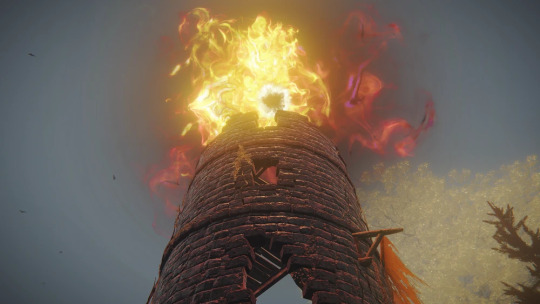
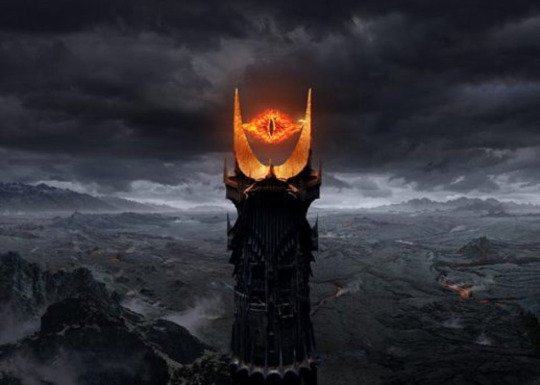
And even more, there's one ring bearer in particular who provides another piece to the puzzle of Radagon and Marika's dual identities. The dissociative identity of Gollum and Smeagol can completely describe the relationship between Marika and Radagon. Two thoughts in one body. With this lens I think that Radagon/Marika were likely not separate entities at the time of their Shattering and may have never had a separate existence. They can appear to hold conversations with each other through reflective surfaces, such as a very shatter-able mirror.
It is quite possible that another Great Rune (or more) will make an appearance in the DLC. If this does happen, I'll re-evaluate Ring of Power theory based on the nature of the added rune.
A Micro Parallel to the Macro Scale
One last note which, again, is oblique enough for plausible deniability. The end of Patches questline would have the Tarnished deliver the Dancer's Castanets to Tanith, inside the volcano. If you know anything about castanets, they are typically made of hard materials such as wood or ivory (or plastic) and carved into a pear shape. Not so for the Dancer's Castanets. From a visual examination these are made of metal cast in a circular shape and with a ring shaped engraving filled with filigree. A metal ring-shaped object delivered to a volcano, echoing the One Ring delivered to Mt. Doom in the Lord of the Rings.
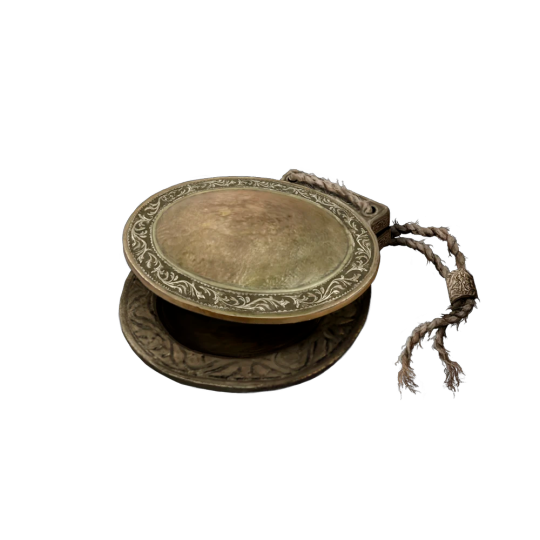
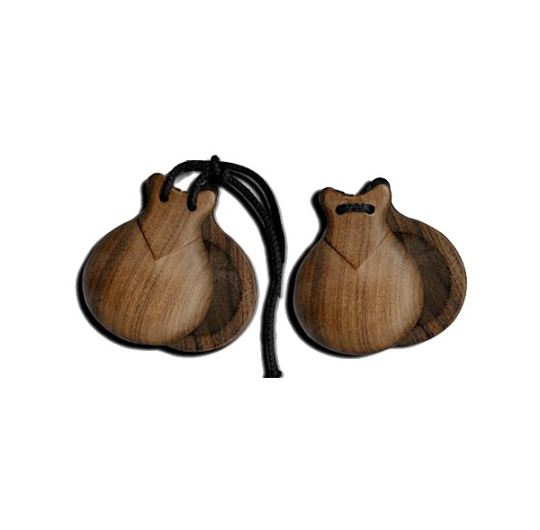
#elden ring#tolkein#elden ring lore#media analysis#Anagram lore: Radagon = a Narog D#D Beholder of Death perhaps#Another anagram: Radagon = Argon Da#Like the sword version of Ringil was wielded by Fingolfin the father of a semi-canon character named 'Argon'#It has a blade that glitters like ice perhaps similar to the 'Frozen Needle' found in the Kingsrealm Ruins#I like when things come in numbered lists such as Durin I to Durin VI matching to the first 6 eras in my ER astrology timeline
5 notes
·
View notes
Text
appendix blog, part 3
“working out... is.... good?”
Hey so I’m skipping Eorl, I already blogged him, or at least I read him. I don’t conceptually separate those processes any more, thanks fiends. I, uh, I meant to type friends there but let’s call it a Freudian typo.
Ah fuck yes after the list of Rohirrim kings it’s time for DURIN’S FOLK
So “Durin is the name that the Dwarves used for the eldest of the Seven Fathers of their race.” Are we ever going to hear about the other six fathers, or is it one of those things where dwarves are extremely close-mouthed about it and only Durin, who they cannot ever shut up about, is ever mentioned near other races?
Durin “slept alone” until the awakening of his people. Did all dwarves sleep alone? Is this a gem kindergarten situation? Please say yes. Please say there is a Durin-shaped hole somewhere that is only known to dwarves and they like, sometimes try to fit themselves into it. The one who is the same size and shape as the original Durin becomes Durin the N+1th. “This hole was made for me,” he declares, and fits himself into it. Everyone cheers, and then they fish him out with a hook before he can slide too far into the mountain. Anyway during the time of Durin VI the dwarves, who are in an absolutely defensible position but are too bored to stop mining, wake up a balrog and have to flee. Durin VI’s son Nain goes to Erebor and finds a very nice rock; most of the Khazad-dum dwarves go to the Grey Mountains in the north, because exploring is fun and profitable! Unfortunately north of the mountain everything is full of dragons. “At last Dáin I, together with Frór his second son, was slain at the door of his hall by a great cold-drake.” I really like the implication I just made up, that the north is full of dragons because they migrated from Angband.
BTW Dain’s other sons are Thror and Gror. Apparently there’s something absolutely essential about the fabric of Ea that makes all peoples independently name their kids dumb themed names. Someone during the Song of Songs or w/e they’re calling it these days accidentally kept repeating one of their trills and it became a line of code essential to the nature of life. Fuck this.
Thror goes to Erebor again, and he makes lots of friendly alliances with other dwarf clans and the humans who live near Erebor (’northmen’). UNFORTUNATELY you cannot have a great and extremely wealthy time around here without a dragon hearing about it, so Smaug the Golden comes to say hi. Thrain II and his dad Thror (original flavor) flee in secret, and then Thror goes into Khazad-dum (possibly it was a suggestion of his Ring). Thror’s bff creeps over to the doors of Khazad-dum and a bunch of orcs are hiding behind the doorframe with Thror’s corpse, presumably working his jaw like a puppet, and laughing their asses off. Written on Thror’s face is the word AZOG. He is king of Khazad-dum now. Thror’s bff tries to take his body for burial, but the orcs throw a sack of small change at his head. It sounds pretty funny to me, but for Nar it’s probably a horrifying parody of a weregild, and an insult. When he looks back, the orcs are hacking up Thror’s body to feed to the local crows. Omg I hope orcs and crows are friends.
Thrain and Nar muster a ton of dwarves to fight, because this will not be borne. They cut through most of the orc strongholds like butter BUT Azog has been saving his strength in Khazad-dum. “So began the Battle of Azanulbizar, at the memory of which the Orcs still shudder and the Dwarves weep.” I LOVE. The fact that absolutely everyone who was involved with this battle in any way has inherited trauma about it. War is no good for anyone at all! Azog has a jolly old time doing murders, until he realizes that HIS guys are actually getting more murdered! He kills Nain and laughs at him, but Nain’s son Dain unexpectedly kills him. It’s accounted extremely heroic, because Dain is like, 16 in dwarf years. It says that “long life and many battles lay before him, until old but unbowed he fell at last in the War of the Ring.” Wait um. Do you mean... the one that takes place in Lord of the Rings? Were dwarves fighting in that?? This is taking place WAY after the Last Alliance isn’t it?? No okay I looked at the end and found the answer, which is that the War of the Ring actually was like 100 years long but relatively low-intensity for most of it.
Anyway,
When at last the battle was won the Dwarves that were left gathered in Azanulbizar. They took the head of Azog and thrust into its mouth the purse of small money, and then they set it on a stake. But no feast nor song was there that night; for their dead were beyond the count of grief. Barely half of their number, it is said, could still stand or had hope of healing.
Half of everyone is dead or dying, and the dwarf alliance still uses their last bit of energy to be petty. Iconic.
Thrain wants to claim Khazad-dum and live there, but everyone else flat-out refuses. Still a balrog in there, dude! I mean, it didn’t bother the orcs, though. I don’t think balrogs really discriminate between orcs and other sorts of dudes, so maybe they could sneak up and kill it in its sleep! But Dain says that the world must change and some other power come before Durin’s folk will live again in Moria. That was Gandalf, right? He did slay the balrog. I hope the dwarves can come back now in the fourth age!! It’s going to take so much fixing up but like... it still exists, mostly intact. A chance to reclaim their heritage.
Thrain and his son Thorin go into exile with the few people who will still follow him--almost everyone is pissed that he got their entire families killed and they can’t even go get treasure in Khazad-dum. So Thrain and co settle in the east of Ered Luin. There’s a bit here about how the Seven Rings turned out to be totally pointless for Sauron because you simply Cannot enslave dwarves. “They were made from their beginning of a kind to resist most steadfastly any domination. Though they could be slain or broken, they could not be reduced to shadows enslaved to another will.” I love the implication that because dwarves were sculpted--note that we never hear AFAIK what elves or humans are made of!--they are more substantial and solid. Mmm I think they have a super solid connection to Arda, and just as even Arda Marred is still largely influenced by the Valar dwarves cannot be wholly corrupted. IDK it’s just the,,, shadow vs stone thing. Sauron enslaves people and it destroys their substance. Dwarves are too substantial? Someone help me out here.
Thrain is still influenced by the Ring, though, driven to go in search of Erebor and its treasure again.
As soon as he was abroad with few companions he was hunted by the emissaries of Sauron. Wolves pursued him, Orcs waylaid him, evil birds shadowed his path, and the more he strove to go north the more misfortunes opposed him. There came a dark night when he and his companions were wandering in the land beyond Anduin, and they were driven by a black rain to take shelter under the eaves of Mirkwood. In the morning he was gone from the camp, and his companions called him in vain...
I love how fairy-tale-ish this passage is. Wolves pursued him! Evil birds shadowed his path! He vanished utterly into air! Sauron was the boojum all along! I’m jazzed about this. Less jazzed about the following explanation: he was kidnapped and tortured in Dol Guldur. Whatever, I guess.
Meanwhile Thorin, who is now king, hammers away on his anvil. It will keep his arm strong. Hella.
Thorin meets Gandalf by accident in an inn in Bree and is like “hey I have been having dreams about you, that’s pretty weird right?” “No no,” says Gandalf, “actually I have been dreaming about you too.” And THAT is how The Hobbit happened.
Wait omg it says here Fili and Kili are Thorin’s “sister-sons.” THIS IMPLIES THE EXISTENCE OF A SECOND DWARF GENDER... WTF... don’t fucking toy with my heart like this Johnald. AH--
Dís was the daughter of Thráin II. She is the only dwarf-woman named in these histories. It was said by Gimli that there are few dwarf-women, probably no more than a third of the whole people. They seldom walk abroad except at great need. They are in voice and appearance, and in garb if they must go on a journey, so like to the dwarf-men that the eyes and ears of other peoples cannot tell them apart. This has given rise to the foolish opinion among Men that there are no dwarf-women, and that the Dwarves 'grow out of stone'.
It is because of the fewness of women among them that the kind of the Dwarves increases slowly, and is in peril when they have no secure dwellings. For Dwarves take only one wife or husband each in their lives, and are jealous, as in all matters of their rights. The number of dwarf-men that marry is actually less than one-third. For not all the women take husbands: some desire none; some desire one that they cannot get, and so will have no other.
Why did they even mention Dis? She doesn’t do anything. I’m retconning, this, obviously. Dwarves just have a super low fertility rate, and woman gender is one of those things that like... doesn’t translate well. There’s no woman gender, because dwarves haven’t invented gender. There’s just dwarves who are currently capable of bearing children. I can’t remember if I got this from Pratchett or not, but it’s a good chance. I just really like the idea that dwarves kind of nod and smile uncertainly when asked to understand a culture that has genders. “Humans really do have an exceptionally high fertility rate,” murmurs one to another. “A lot of ‘women.’” “One just can’t keep track of them,” sighs the other. This is kind of incoherent because Tolkien is actively trying to ruin it, but whatever. Moving on.
After the fall of Sauron, Gimli brought south a part of the Dwarf-folk of Erebor, and he became Lord of the Glittering Caves. He and his people did great works in Gondor and Rohan. For Minas Tirith they forged gates of mithril and steel to replace those broken by the Witch-king. Legolas his friend also brought south Elves out of Greenwood, and they dwelt in Ithilien, and it became once again the fairest country in all the westlands.
Nice! Gay! Also holy shit, mithril gates. Where the hell did they get all that. Hey maybe Sauron had a huge stockpile of mithril and some people went to sift thru the wreckage of Mordor and reclaim it. Radical.
We have heard tell that Legolas took Gimli Glóin's son with him because of their great friendship, greater than any that has been between Elf and Dwarf. If this is true, then it is strange indeed: that a Dwarf should be willing to leave Middle-earth for any love, or that the Eldar should receive him, or that the Lords of the West should permit it.
Hey. Hey. That’s gay.
9 notes
·
View notes